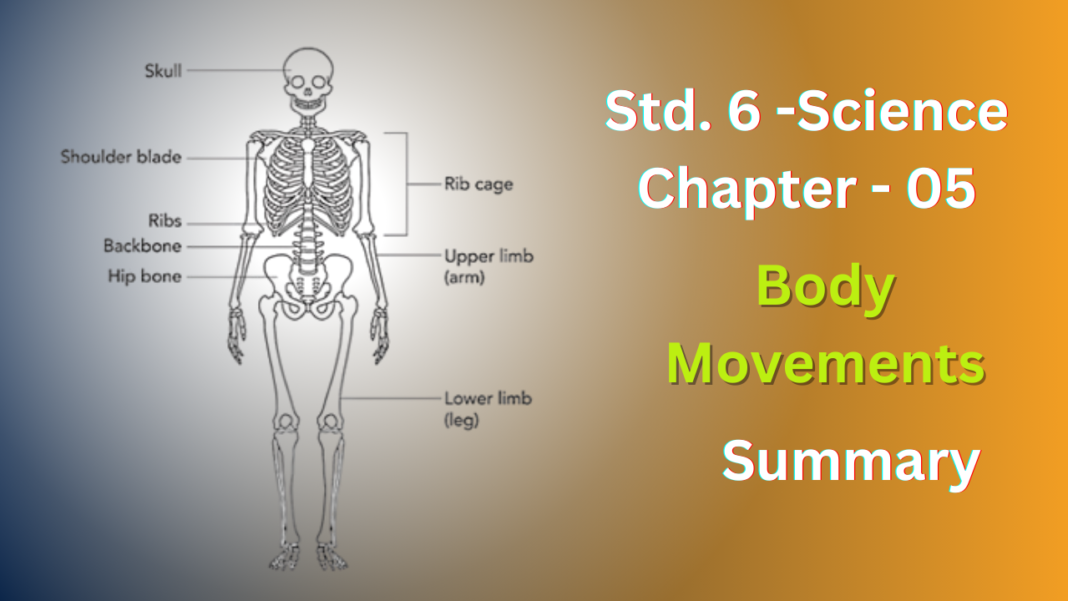NCERT Solutions for Class 6 Science Chapter 5: Body Movements
The “Body Movements” chapter in your 6th-grade science book focuses on the amazing ability of humans and animals to move their bodies.
1. The Skeletal System:
- The skeleton is a framework of bones that provides support, shape, and protection to the body.
- Joints connect various bones, allowing for movement at different points in the body.
- There are different types of joints, such as hinge joints (elbows, knees) that allow bending and straightening, and ball-and-socket joints (shoulders, hips) that allow for wider movement range.
2. The Muscular System:
- Muscles are tissues that contract and relax, causing movement in the body.
- Muscles are attached to bones at tendons and work in pairs (antagonist and agonist) to produce movement.
- Voluntary muscles are controlled consciously (e.g., moving your arm), while involuntary muscles function automatically (e.g., breathing).
3. The Nervous System:
- The nervous system plays a crucial role in coordinating and controlling body movements.
- The brain sends signals through nerves to the muscles, directing their contraction and relaxation.
4. Importance of Movement:
- Body movements are essential for various daily activities like walking, running, jumping, and grasping objects.
- Exercise strengthens muscles and bones, improves flexibility, and maintains overall health and well-being.
Exercises
NCERT Solutions for Class 6 Science Chapter 5: Body Movements – Education85
1. Fill in the blanks:
(a) Joints of the bones help in the____of the body.
(b) A combination of bones and cartilages forms the_____of the body.
(c) The bones at the elbow are joined by a_____joint.
(d) The contraction of the_____pulls the bones during movement.
Ans : a)movement
(b skeleton
(c) hinge
(d) muscles
2. Indicate true (T) and false (F) among the following sentences.
(a) The movement and locomotion of all animals is exactly the same.
(b) The cartilages are harder than bones.
(c) The finger bones do not have joints.
(d) The fore arm has two bones.
(e) Cockroaches have an outer skeleton.
Ans : (a) False (F)
(b) False (F)
(c) False (F)
(d) True (T)
(e) True (T)
3. Match the items in Column I with one or more items of Column II
| Column I | Column II |
| Upper JawFishRibsSnailCockroach | Have fins on the bodyHas an outer skeletonCan fly in hairIs an immovable jointProtect the heartShows very slow movementHave a streamlined body |
Ans :
| Column I | Column II |
| Upper jaw | Is an immovable joint |
| Fish | Have fins on the body,Have a streamlined body |
| Ribs | Protect the heart , |
| Snail | Shows very slow movement |
| Cockroach | Has an outer skeleton,Can fly in hair |
4. Answer the following:
(a) What is a ball and socket joint?
Ans : A ball and socket joint is a type of movable joint found in the human body that allows for a wide range of movement in multiple directions.
(b) Which of the skull bones are movable?
Ans : The Mandible or lower jaw.
The mandible connects to the temporal bone of the skull at the temporomandibular joint (TMJ), which allows for up-and-down movement of the jaw.
(c) Why can our elbow not move backwards?
Ans : Our elbow cannot move backward because it is a hinge joint. Hinge joints, like the door hinge they are named after, allow movement in only one direction: flexion and extension. Flexion is bending the joint, like bringing your hand towards your shoulder. Extension is straightening the joint, like pushing your arm straight out.
FAQ’s
What topics are covered in NCERT Solutions for Class 6 Science Chapter 5?
Chapter 5 of Class 6 Science covers various aspects of body movements, including types of movements, skeletal system, and muscles.
How do NCERT Solutions for Class 6 Science Chapter 5 help in understanding body movements?
These solutions provide detailed explanations and illustrations to help students understand the different types of movements performed by the human body and how they are coordinated.
What are some key concepts related to body movements discussed in NCERT Solutions for Class 6 Science Chapter 5?
Concepts include the types of joints, structure and function of bones, muscles, and how the nervous system controls movements.
Are there any real-life examples or activities provided in NCERT Solutions for Class 6 Science Chapter 5 to help understand body movements better?
Yes, the solutions may include activities such as observing and labeling the bones and muscles in the human body, performing simple exercises to understand muscle actions, and exploring the range of motion of different joints.
How can students apply the knowledge gained from NCERT Solutions for Class 6 Science Chapter 5 in their daily lives?
Students can apply their understanding of body movements to activities such as sports, dance, yoga, and maintaining good posture and ergonomics to prevent injuries.









